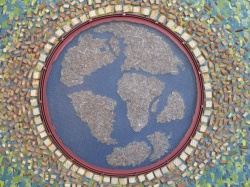[Requiem Series to Gaia] Since the 80, the ecological theme is a constant in my artistic production, as well as the incorporation of computers boards and other types of technological and electronic accessories. The series REQUIEM TO GAIA treats on the current situation of the environmental degradation in the planet provoked by the actions of the human being avid for an immediate enrichment. Six circular pictures represent regions of the planet, through geographical maps, and the environmental pollution pertinent to each one. Each region is painted in a realistic way, as a detail of each work, and put inside of a glass cupola, in order to create a link that encloses the painting in itself. Mundi I, represented by a world map, it is the seventh work and approaches the materialistic character of our contemporary society. The series of works was accomplished in mixed technique: oil + computer pieces and several objects on wood, besides hand written texts and plastic film of PVC (Polyvinyl chloride) to create textures and peculiar visual effects that, compared to the other elements attached to the pictures, provoke the spectator's curiosity. There is also the incorporation to the pictures of several elements of our daily technology, such as, computer boards (sawed and polished with emery), processors, chips, speakers, credit cards, clocks, keys, padlocks, cupolas of clocks, bullets, jewelries, coins, burned matches picks, peels of pointed pencil, rubber eraser bran etc; besides elements of the nature, such as, seeds, shells, snails, earth, polishes, stones, armadillo skull etc. All of this has the intention to provoke philosophical reflections on the environmental quest related to the activities of mankind in the planet. In that sense, the six regions of the planet were filled out with remains of objects related to the characteristics of each region, in order to represent the pollution caused by the excessive consumption of materials processed by the human industry, so:
- in the world map presents all the regions of the planet filled out with credit cards, a great symbol of the wild consumerism of the contemporary society.
- in Africa, I used sand due to the influence, remarkable of Sahara, as well as of the drought in several areas of that continent;
- in North America, I used several chips and computer processors to represent the characteristic of the technological society;
- in South America, I used burned match picks to represent the burning rain forest;
- In Asia, I used peels of pointed pencil to represent the manual culture that still today remains imperative in the region;
- in Europe, I used small pieces of computer plates to set up a representative visual mosaic of the several mini areas that compose the continent;
- in Oceania, I used debris of computer plates to represent the dominant industrial production in this area that has been supplying the world market of electronic goods in the last decades.
At the background of some pictures I wrote by hand a text following lineal pattern composition specific for each work. This text, Letter of the Chief Seattle, is globally known and has a very curious history: The North American indigenous chief, Seattle, made a speech, in 1855, during a peace treaty in which the indigenous lands were sold in exchange for a reservation. That speech was witnessed by an admirer of him, Henry A. Smith, that published a text in a local newspaper in 1887, based on his memories on the speech. In 1971, the speech suffered alterations done by a scriptwriter, Ted Perry, for a documentary with ecological theme. Since then, the text of that documentary became known globally as the letter answer of Chief Seattle to the North American president, Franklin Pearce. Although, the authorship is ambivalent, that communion of texts, in my opinion, presents a message for the humankind that turns itself more and more up to date. Therefore, I decided to include it in this new series of works named REQUIEM TO GAIA. In synthesis: In my artistic production, I always try to unite the reason to the feeling (basis of my creative process), to create a work that makes use of traditional techniques incorporated to elements of our current society and that establishes several metonymical relationships in order to provoke questions on the spectator. My intention is that he reaches his own conclusions on the approached theme through a subjective language. The outcome is the complicity or the denial, it doesn't matter, because both form a kind of involvement that turn back to the essence of what I intend to transmit. See photos of making of IN TOTUM Also read about Projeto Seattle Comentário sobre Projeto Seattle Carta do Chefe Seattle Leia e assista as matérias sobre essa série Anuário Brasileiro de Artes Plásticas Consulte - 2009 Volume VII Anuário Luso Brasileiro de Artes 2010/2011 PUC Viva 2012 - Espaço Cultural FCET recebe exposição sobre tecnologia
